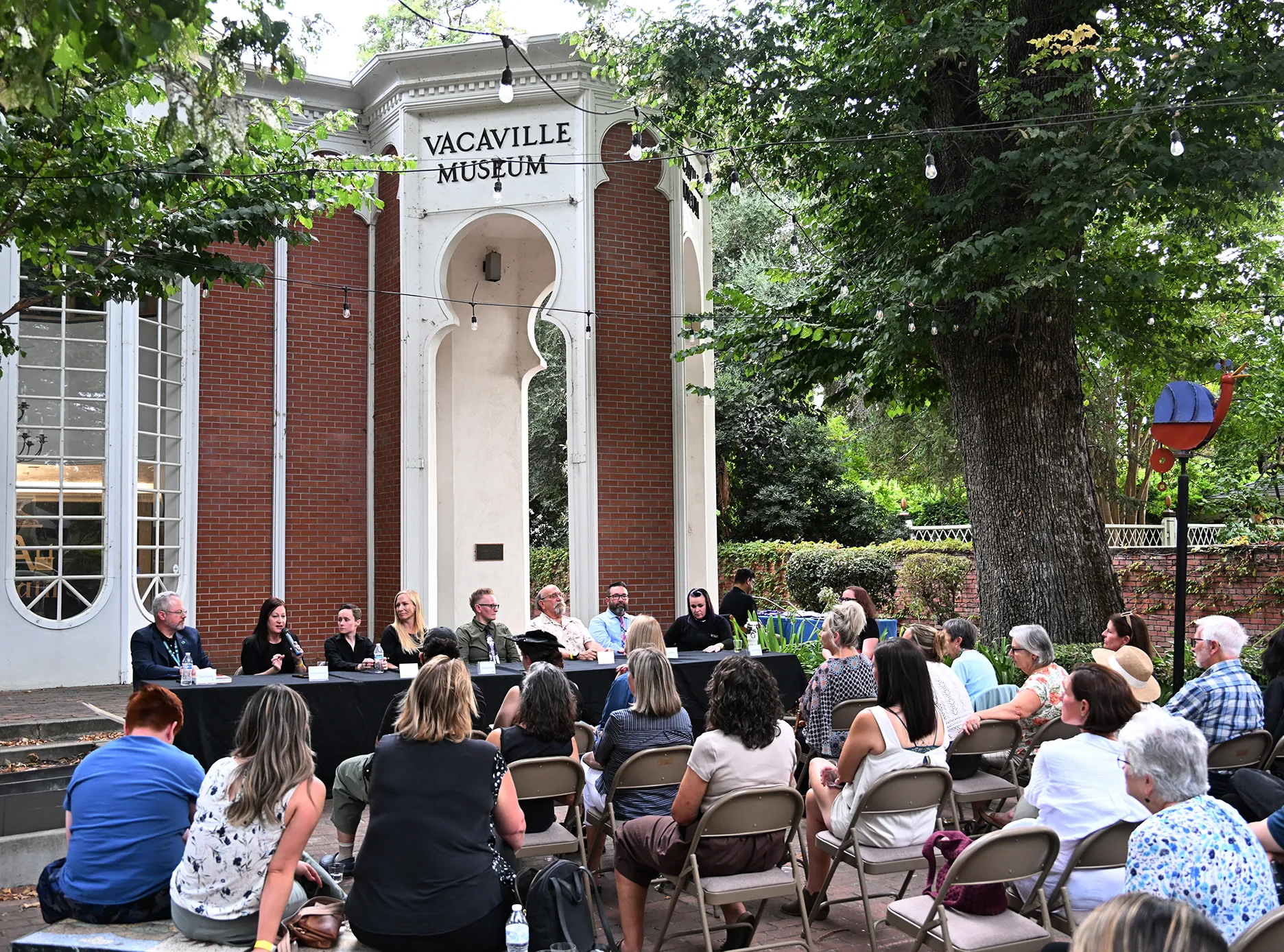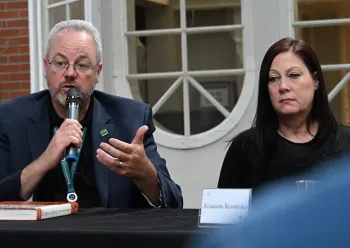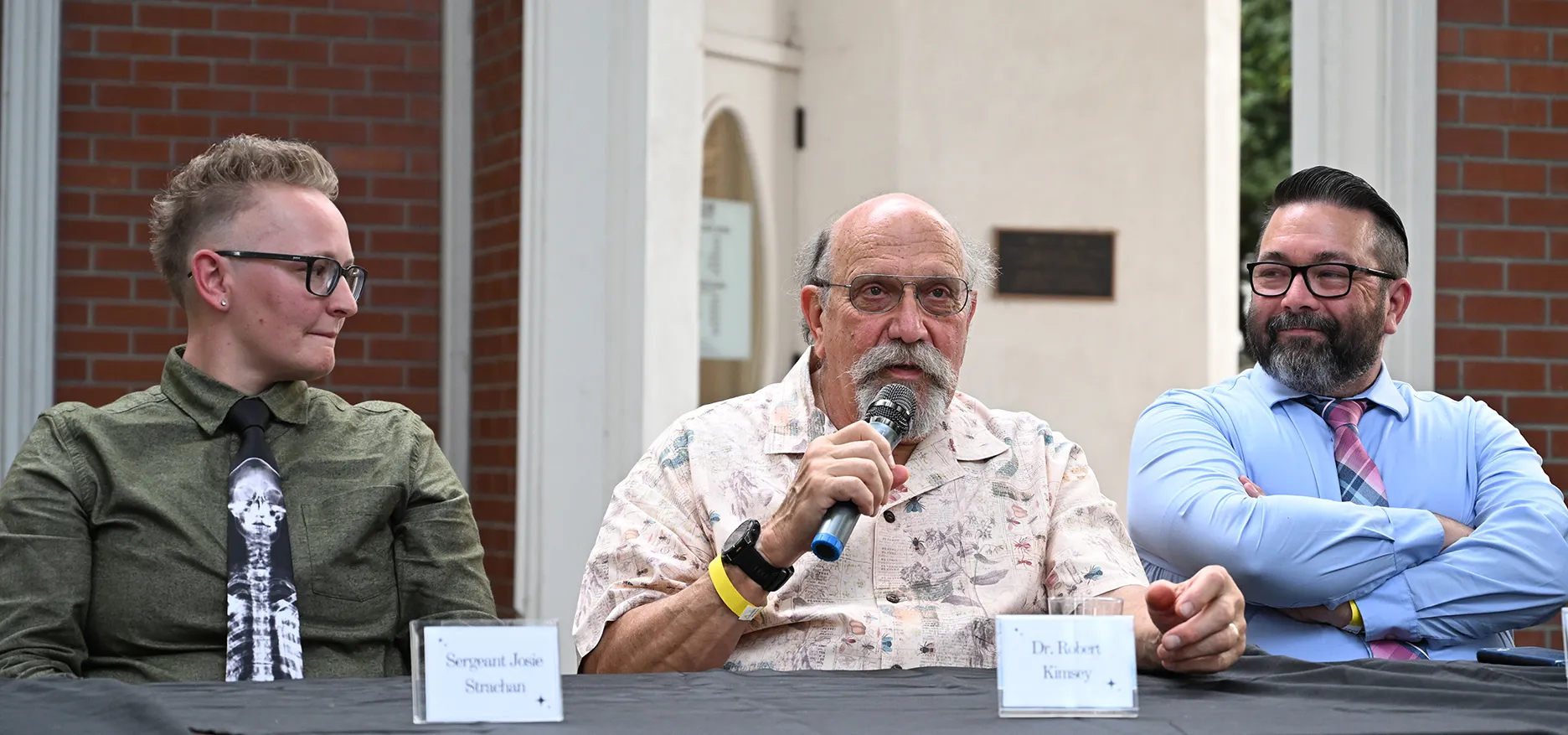
"It's one universal experience we all will share."
So said a panel of eight professional experts in the death industry when they gathered in the Vacaville Museum courtyard to discuss their work. The museum hosted the panel discussion as part of its current gallery exhibition, "The Art of Death," which continues through Nov. 15.

The panelists included forensic entomologist Robert Kimsey, emeritus faculty member of the UC Davis Department of Entomology and Nematology and a past president of the North America Forensic Entomology Association. Although retired from teaching at UC Davis, he continues his research and public service.
He joined Chris Donhost, coroner and funeral services liaison at Sierra Donor Services; Amanda Kostenko, service manager at the Neptune Society of Northern California; Heather Strachan, general manager, Vacaville-Elmira Cemetery District; Sgt. Josie Strachan, chief deputy coroner at Nevada County Sheriff’s/Coroner’s Office; Deputy Jessica Dew, coroner investigator, Solano County Coroner's Office; Shannon Parra, lead embalmer at Bryan-Braker Funeral Home, Fairfield; and Vince Stone, managing funeral director at McCune Garden Chapel, Vacaville, and Milton Carpenter Funeral Home, Dixon.
A few of the panelists' comments:
- "We go to work to help people in their most difficult time and I am proud of who I am and what I'm doing."
- "I wear black all the time because I don't feel comfortable in colors."
- "Death will either tear a family apart or bring them together."
- Organ donations are so appreciated: Donors affiliated with the Sierra Donor Services have ranged from babies to a 98-year-old.
- In California, there are more cremations than traditional burials--approximately 69 to 70 percent of Californians are now choosing cremation.
- American River College, Sacramento, not only offers a degree in mortuary science or funeral service education, but as of this year, it is the first college in the nation to open and operate its own fully functioning mortuary on campus. Students learn the full death care process on site—from embalming to holding services.

In his presentation, Kimsey said his work involves the rate at which insects develop and a body decomposes, but this process is affected by a wide range of environmental and physical variables. Among the factors crucial in estimating the post-mortem interval (PMI) are temperature, humidity, wind, and body location.

Kimsey mentioned that one of his first encounters as a forensic entomologist at UC Davis included assisting with the case against Dorothea Fuentes, a serial killer who owned a Sacramento boarding house and murdered at least nine tenants between 1982 and 1988. She preyed on the elderly and mentally disabled tenants, cashing in their Social Security checks. Investigators said that Fuentes buried at least seven bodies in her backyard.
The panel also touched on "Maggot Art." Donhost recalled a conference activity: dipping maggots in paint and dropping them on a piece of paper to create "insect masterpieces." One of Kimsey's former graduate students, Rebecca O'Flaherty, coined the educational teaching curriculum, "Maggot Art," in 2001 when she was studying at the University of Hawaii. She was rearing blowflies for her forensic research and wanted an activity to draw the interest of elementary school students. She also wanted to generate interest and respect for forensic entomology. It was O'Flaherty who introduced Maggot Art to the UC Davis campus. It it is now a traditional part of the Department of Entomology and Nematology's UC Davis Picnic Day activities at Briggs Hall. The Bohart Museum of Entomology, under the direction of UC Davis Distinguished Professor (now emerita) Lynn Kimsey, has also featured it as a children's arts and crafts activity at several open houses.
Vacaville Museum curator Shelby Sorensen moderated the panel discussion and directed the question-and-answer period.
'Art of Death' Gallery Exhibit
The Vacaville Museum gallery exhibit at 213 Buck Ave., Vacaville, zeroes in "on how people across time and cultures have sought to make sense of the mystery of death, with acceptance and fear intertwined with curiosity," said Vacaville Museum executive director Clara Dawson. Filtered through the lenses of art, history, science, and culture, "The Art of Death" explores the ways society depicts, honors, and confronts death “to reveal how our relationship with mortality continually evolves,” she said.
The Bohart Museum contributed to the gallery exhibit. Projects include "Ephemeral Resources," "Dermestid Damaged Drawer," and three curated insect specimens: a monarch butterfly, Danaus plexippus; death's head hawkmoth, Acherontia sp.; and a flame skimmer dragonfly, Libellula saturata.
Robert Kimsey praised the gallery exhibit in an email to the museum officials: "Your exhibition is extremely interesting and treats death in a unconventionally accessible way. No Hollywood style excessively jarringly terrifying nonsense designed to 'entertain' peculiar components of the community. Rather a very grounded presentation of the realities of death and how components of our rather diverse community have come to perceive, respond to and incorporate death into their cultures. It gave me pause for a lot of thought. You cannot fear the inevitable, you must plan for it."
The Vacaville Museum is planning numerous other activities dealing with the gallery exhibit. See Events at https://vacavillemuseum.org/events/


